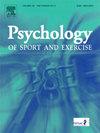(Re)conceptualizing cohesion: A theoretical realignment and roadmap for future research
IF 3.3
2区 心理学
Q2 HOSPITALITY, LEISURE, SPORT & TOURISM
引用次数: 0
Abstract
Cohesion, or the unity of a group, has received substantial attention in popular media and from researchers across several contexts. Over the past 40 years, researchers interested in understanding and investigating cohesion in sport have relied predominantly on the work of Carron and colleagues (1985) who outlined their conceptual foundation for the construct and developed the Group Environment Questionnaire. Although their conceptual framework and measurement tool have been useful to gain an understanding of relationships between cohesion and its potential antecedents and outcomes, a closer inspection of its theoretical bases and concomitant definitions provides an opportunity for improved theorizing. In the present review, we revisit the work of Carron and colleagues (1985), the construct of cohesion itself, the state of the literature, and apply a critical eye toward the role that cohesion plays in contributing to a group's dynamics and functioning within sport. In doing so, we identify several concerns with the current state of knowledge regarding cohesion and offer a series of propositions to define, conceptualize (two-dimensional model of cohesion consisting of task and social integration), and more effectively link key inputs contributing to the unity of the group (i.e., interdependence, social identity, teamwork). We believe that there is a pressing need to (re)conceptualize the construct and have proposed a theoretical model for cohesion, as well as a future research agenda, that we hope will reinvigorate research on cohesion in sport and beyond.
(二)内聚概念:理论梳理与未来研究路线图。
凝聚力,或群体的统一,在大众媒体和不同背景下的研究人员中受到了极大的关注。在过去的40年里,对理解和调查体育凝聚力感兴趣的研究人员主要依赖于Carron及其同事(1985)的工作,他们概述了他们构建的概念基础,并开发了群体环境问卷。尽管他们的概念框架和测量工具对于理解内聚及其潜在的前因和结果之间的关系很有用,但对其理论基础和伴随定义的更仔细检查为改进理论化提供了机会。在本综述中,我们回顾了Carron及其同事(1985)的工作,凝聚力本身的构建,文献的状态,并对凝聚力在促进体育运动中群体动态和功能方面所起的作用进行了批判性的观察。在此过程中,我们确定了关于凝聚力的当前知识状态的几个问题,并提供了一系列命题来定义,概念化(由任务和社会整合组成的凝聚力的二维模型),并更有效地将有助于群体团结的关键输入(即相互依存,社会认同,团队合作)联系起来。我们认为,迫切需要(重新)概念化这一结构,并提出了凝聚力的理论模型,以及未来的研究议程,我们希望这将重振体育及其他领域的凝聚力研究。
本文章由计算机程序翻译,如有差异,请以英文原文为准。
求助全文
约1分钟内获得全文
求助全文
来源期刊
CiteScore
6.40
自引率
5.90%
发文量
172
审稿时长
69 days
期刊介绍:
Psychology of Sport and Exercise is an international forum for scholarly reports in the psychology of sport and exercise, broadly defined. The journal is open to the use of diverse methodological approaches. Manuscripts that will be considered for publication will present results from high quality empirical research, systematic reviews, meta-analyses, commentaries concerning already published PSE papers or topics of general interest for PSE readers, protocol papers for trials, and reports of professional practice (which will need to demonstrate academic rigour and go beyond mere description). The CONSORT guidelines consort-statement need to be followed for protocol papers for trials; authors should present a flow diagramme and attach with their cover letter the CONSORT checklist. For meta-analysis, the PRISMA prisma-statement guidelines should be followed; authors should present a flow diagramme and attach with their cover letter the PRISMA checklist. For systematic reviews it is recommended that the PRISMA guidelines are followed, although it is not compulsory. Authors interested in submitting replications of published studies need to contact the Editors-in-Chief before they start their replication. We are not interested in manuscripts that aim to test the psychometric properties of an existing scale from English to another language, unless new validation methods are used which address previously unanswered research questions.

 求助内容:
求助内容: 应助结果提醒方式:
应助结果提醒方式:


